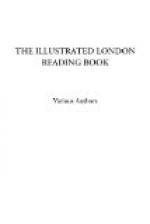[Illustration]
The remains of Strata Florida Abbey, in South Wales, are most interesting in many points of view, more especially as the relics of a stately seminary for learning, founded as early as the year 1164. The community of the Abbey were Cistercian monks, who soon attained great celebrity, and acquired extensive possessions. A large library was founded by them, which included the national records from the earliest periods, the works of the bards and the genealogies of the Princes and great families in Wales. The monks also compiled a valuable history of the Principality, down to the death of Llewellyn the Great. When Edward I. invaded Wales, he burned the Abbey, but it was rebuilt A.D. 1294.
Extensive woods once flourished in the vicinity of Strata Florida, and its burial-place covered no less than 120 acres. A long list of eminent persons from all parts of Wales were here buried, and amongst them David ap Gwillim, the famous bard. The churchyard is now reduced to small dimensions; but leaden coffins, doubtless belonging to once celebrated personages, are still found, both there and at a distance from the cemetery. A few aged box and yew-trees now only remain to tell of the luxuriant verdure which once grew around the Abbey; and of the venerable pile itself little is left, except an arch, and the fragment of a fine old wall, about forty feet high. A small church now stands within the enclosure, more than commonly interesting from having been built with the materials of the once celebrated Abbey of Strata Florida.
* * * * *
KAFFIR CHIEFS.
[Illustration]
In the warm summer months a thin kind of petticoat constitutes the sole bodily attire of the Kaffir Chiefs; but in winter a cloak is used, made of the skins of wild beasts, admirably curried. The head, even in the hottest weather, is never protected by any covering, a fillet, into which a feather of the ostrich is stuck, being generally worn; and they seldom wear shoes, except on undertaking a long journey, when they condescend to use a rude substitute for them. The bodies of both sexes are tattooed; and the young men, like the fops of more civilized nations, paint their skins and curl their hair. Their arms are the javelin, a large shield of buffalo-hide, and a short club.
The women exhibit taste in the arrangement of their dress, particularly for that of the head, which consists of a turban made of skin, and profusely ornamented with beads, of which adornment both men and women are very fond. A mantle of skin, variously bedecked with these and other showy trinkets, is worn; and the only distinction between the dress of the chieftains’ wives and those of a lower rank consists in a greater profusion of ornaments possessed by the former, but of which all are alike vain. There is no change of dress, the whole wardrobe of the female being that which she carries about with her and sleeps in, for bed-clothes they have none.




